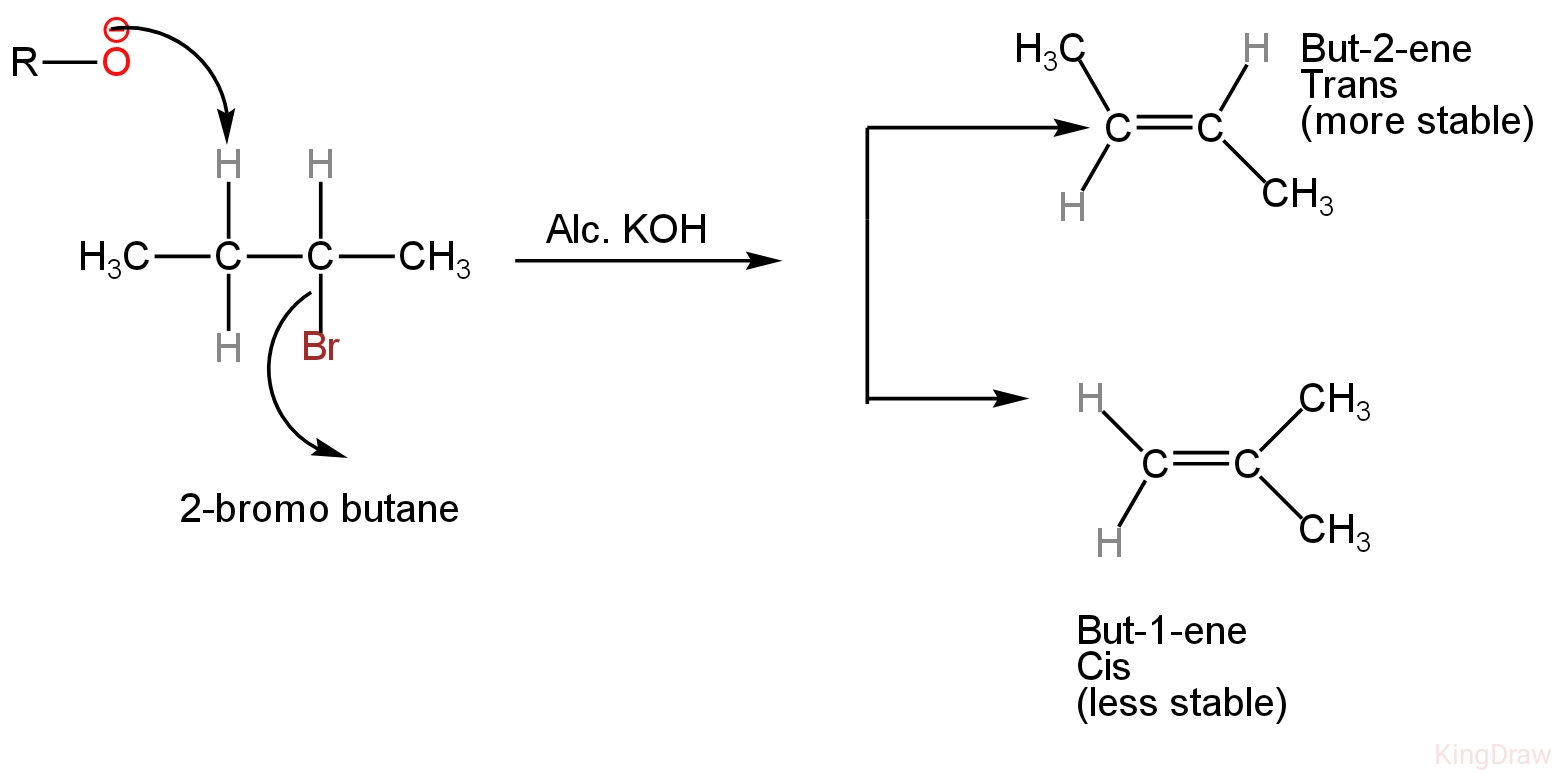
When 2-bromobutane reacts with alcoholic KOH, the reaction is called
A. Halogenation
B. Hydrogenation
C. Chlorination
D. Dehydrohalogenation
Answer
223.5k+ views
Hint: When a haloalkane reacts with an alcoholic potassium hydroxide (KOH) solution, an alkene is created as the product. A halogen atom and a hydrogen atom from the haloalkane get removed in the form of hydrogen halide.
Complete Step by Step Answer:
When hydrogen in an alkane is replaced by a halogen atom, haloalkane is formed.
Alcoholic KOH is a concentrated alcoholic
solution of potassium hydroxide.
Alcoholic KOH disintegrates in water forming\[R{O^ - }\]ions which is a strong base.
It takes hydrogen from the haloalkane.
The carbon atom which carries the halogen atom is\[\alpha \]-carbon.
The carbon atom which holds the hydrogen atom is the\[\beta \]-carbon.
The hydrogen atom is eliminated from \[\beta \]carbon, this reaction is similarly called the \[\beta \]-elimination reaction.
In this reaction, a halogen atom and a hydrogen atom from the haloalkane are withdrawn in the form of hydrogen halide.
So, it is called a dehydrohalogenation reaction.
It is an elimination reaction.
For instance - dehydrobromination of bromoethane

Image: Dehydrobromination of bromoethane forming ethene.
In the given reaction, the α-carbon loses the bromine atom and the\[\beta \]-carbon loses the hydrogen atom.
The resulting product is an alkene.
Here in this question, we are given 2-bromobutane which is treated with alcoholic KOH.

Image: Dehydrobromination of 2-bromobutane.
So, when 2-bromobutane reacts with alcoholic KOH, the reaction is called dehydrohalogenation.
So, option D is correct.
Note: Formation of but-2-ene as the main product according to Saytzeff’s rule.
It states that if an alkyl halide can undergo elimination in two distinct ways, then the more highly substituted alkene or the alkene possessing a deficient number of hydrogens on the doubly bonded carbon atoms is the major product of dehydrohalogenation reaction.
Complete Step by Step Answer:
When hydrogen in an alkane is replaced by a halogen atom, haloalkane is formed.
Alcoholic KOH is a concentrated alcoholic
solution of potassium hydroxide.
Alcoholic KOH disintegrates in water forming\[R{O^ - }\]ions which is a strong base.
It takes hydrogen from the haloalkane.
The carbon atom which carries the halogen atom is\[\alpha \]-carbon.
The carbon atom which holds the hydrogen atom is the\[\beta \]-carbon.
The hydrogen atom is eliminated from \[\beta \]carbon, this reaction is similarly called the \[\beta \]-elimination reaction.
In this reaction, a halogen atom and a hydrogen atom from the haloalkane are withdrawn in the form of hydrogen halide.
So, it is called a dehydrohalogenation reaction.
It is an elimination reaction.
For instance - dehydrobromination of bromoethane

Image: Dehydrobromination of bromoethane forming ethene.
In the given reaction, the α-carbon loses the bromine atom and the\[\beta \]-carbon loses the hydrogen atom.
The resulting product is an alkene.
Here in this question, we are given 2-bromobutane which is treated with alcoholic KOH.

Image: Dehydrobromination of 2-bromobutane.
So, when 2-bromobutane reacts with alcoholic KOH, the reaction is called dehydrohalogenation.
So, option D is correct.
Note: Formation of but-2-ene as the main product according to Saytzeff’s rule.
It states that if an alkyl halide can undergo elimination in two distinct ways, then the more highly substituted alkene or the alkene possessing a deficient number of hydrogens on the doubly bonded carbon atoms is the major product of dehydrohalogenation reaction.
Recently Updated Pages
JEE General Topics in Chemistry Important Concepts and Tips

JEE Extractive Metallurgy Important Concepts and Tips for Exam Preparation

JEE Atomic Structure and Chemical Bonding important Concepts and Tips

JEE Amino Acids and Peptides Important Concepts and Tips for Exam Preparation

Electricity and Magnetism Explained: Key Concepts & Applications

JEE Energetics Important Concepts and Tips for Exam Preparation

Trending doubts
JEE Main 2026: City Intimation Slip Expected Soon, Application Form Closed, Exam Dates, Syllabus & Eligibility

JEE Main 2026 Application Login: Direct Link, Registration, Form Fill, and Steps

Understanding the Angle of Deviation in a Prism

How to Convert a Galvanometer into an Ammeter or Voltmeter

Ideal and Non-Ideal Solutions Explained for Class 12 Chemistry

Hybridisation in Chemistry – Concept, Types & Applications

Other Pages
NCERT Solutions For Class 12 Chemistry Chapter 1 Solutions - 2025-26

Solutions Class 12 Chemistry Chapter 1 CBSE Notes - 2025-26

JEE Advanced Marks vs Ranks 2025: Understanding Category-wise Qualifying Marks and Previous Year Cut-offs

Biomolecules Class 12 Chemistry Chapter 10 CBSE Notes - 2025-26

NCERT Solutions for Class 12 Chemistry Chapter 2 Electrochemistry

NCERT Solutions For Class 12 Chemistry Chapter 10 Biomolecules - 2025-26




